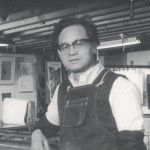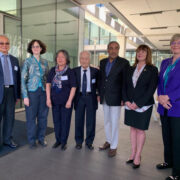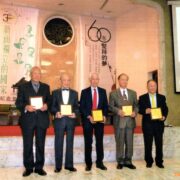廖修平的藝術 THE ART OF SHIOU-PING LIAO
序
國際知名的版畫家,也是推動台灣規代版畫藝術 的第一人廖修平先生,二十餘年來,致力於版畫的創 作,推廣與提昇台灣的版畫藝術活動,此外亦廣泛地 涉及各種媒材的表達,如油畫、水彩、壓克力混含媒 體等。他的藝術風格即是在運用不同媒材創作的相互 刺激與影響下,逐漸發展形成的。作品中濃厚的中國 文化藝術思想與台灣鄕土精神,糞立了他個人獨特的 風格而蜚聲國際。本舘策畫擧辦一系列海外美術作品 展,以研究台灣傑出藝術家,在東、西文化衝擊下的 創作歷程,並推介與肯定其在國際藝壇的努力與成就 。廖修平作品展即本系列的首項大展。
廖修平一九三六年生於台北,成長於建築世家, 家居台北古城艋舺的龍山寺附近,幼承庭訓,過着崇天法祖的樸質生活,影響日後他在選擇藝術創作上的 主題與風格表現至深。一九五四年進入國立台灣師範 大學美術系,油畫、水彩、版畫無不兼擅。一九六二 年赴日進修,除了繼續研習油畫,更開始探訪銅版畫 與石版畫的表現,作品亦履獲獎。課餘在高橋正人的 視覺設計研究所學習構成原理與視覺設計等,對其日 後作品「門系列」風格的建立,有意想不到的肋益。 爲了繼續對藝術的追求,於一九六五年赴法,進入巴 黎藝術學院及第十七版畫研究所研究西洋油畫與金屬 版畫。在巴黎這個與東方文化及社會形態完全迥異的 環境裡,廖修平在三年的探索與奮鬥中,更由版畫創作中逐漸尋回自己文化的根,建立起個人獨特的風格 。作品屢獲大獎,其聲譽鵲起,亦絕非偶然。
一九六九年移居美國,爲尋求新的發展與成長, 他加入紐約布拉特版畫中心,研究更多不同的版畫技 巧,從而融會貫通而至揮灑自如的境界。一九七三年 ,應母校台灣師範大學之邀,回國敎授版畫課程,並致力推動國內版畫活動等,促使了「十靑版畫會」等 團體的成立,貢獻菲薄。一九七七年復應日本筑波大 學之聘,主持該校版畫課兩年半,一九七九年回到新澤西州,執敎於西東大學藝術系。
廖修平的版畫藝術,享譽國際,至於其他媒材的 創作,也仍是不遣餘力,時有創新。其作品主要風貌 可分四期:一九六八年–七三年,以「門」爲象徵 的記號探討內在心象世界的表現。一九七九—八四 年的「四季之情與田園風味期」,爲物我含一世界的表白。 一九八四–八八年的「木頭人的禮讚」,是 對今日機械文明的反應。_九八八年至今的「窗與牆 的寓意畫」,則是宗敎情懷的傾訴。二十年來,他作 品的主題與風格,在不同媒材的交替使用中演變與發 展。取材由懷鄕與兒時記懦中的廟、門、民俗文物及 日常生活之器皿、果蔬等,探討人與宇宙關係之和諧 ,陰陽循環之道,表達恒常靜謐之心靈境界。「木頭 人」則在因應機械文明下,傳達現代人追求幸福快樂 的積極精神。近期作品更以心靈之「窗」來審視與詮 釋想像世界;「牆」則寓指人生必經的種種障礙與困 境;老樹、岩石等象徵永恆的存在,而人惟有皈依於 佛–這萬能的主宰,才得永生,入世而後出世之意 境,昭然可見。作品中的方格與木盒,象徵着某種秩 序、是家、規格化的社會、都市文明或悠久的傳統。 而貫穿每一時期風格的「彩虹」,是理想與生命之光 ,扮演着銜接有限生命與永恒存在的角色,也呈現出廖修平創作中的恒常信念。
廖修平從事創作二十餘年,成就卓著,本舘特擧 辦此回顧性展覽,藉表欽佩。約兩百件作品,包括油 畫、水彩、壓克力畫與版畫,爲其各期代表作,希與 國內大衆共探其東方智慧之奧妙。
The world-famous graphic artist Shiou-Ping Liao is also the first among modern graphic artists in Taiwan. He not only devotes himself to print-making and promotes the graphic art activities in Taiwan but also widely applies different media such as oil, water-color, acrylic for his artistic expression. His works are filled with traditional Chinese art and cultural ideology and philosophy as well as Taiwanese folk art motifs, which help to establish his unique style and his fame in the world. The exhibition of Shiou-Ping Liao is the first in this series of exhibitions of outstanding overseas Chinese artists the Taipei Fine Arts Museum is organizing to study their artistic development as interrelation between Eastern and Western culture, and to confirm their endeavors and achievement in the world of art.
Shiou-Ping Liao was born in Taipei in 1936, grew up in an architect’s family and lived by the old Lung-San Temple in Taipei. Liao entered the art department of National Taiwan Normal University and studied oil painting, watercolor, and printing in 1954. To further his studies of Western art, Liao went to Japan in 1962 to the Tokyo University of Education. He absorbed the flourishing fascination there with graphic art, and devoted himself especially to intaglio and lithograph in addition to his regular studies in oil painting. Liao attended Paris’ Ecole National Superieure des Beaux- Arts and Atelier 17 to study Western oil painting and graphics especially “copperplate” techniques in 1965. After three- years’ study and searching for his own style in Paris, an environment totally different from Oriental societies, Liao gradually found his root of Chinese heritage taking artistic expression in his print-making. Here he established his unique style.
In 1969, Liao decided to live in New York and become a professional graphic artist. He enrolled in the Pratt Graphic Art Center learning more about various printing techniques In 1973 at the invitation of his home campus, NTNU, he returned to Taipei as the head of that university’s graphic art classes, as well as professor of printmaking to other schools. Under his tutelage and promotion, the graphic art of this country flourished, and the “Evergreen Association of the Prinr was established. Liao returned to Japan in 1977 at the invitation of Tsukuba University and taught printmaking for two years. Going back to New York in 1979, he headed the graphic art division in Seton Hall University’s art department and at the Art Center of Northern New Jersey.
Liao’s graphic-art has made an impact all over the world now, yet he continues to apply various media to his artistic expression and is ever evolving his art into something startlingly new and lastingly exciting. We could divide his works into four major periods: 1. 1968-73, “Gate” period; using the symbolic sign of entrance and exit to explore the parallel images and idioms of the limited and limitless within one’s mind. 2. 1979-84, “the mood of Four Season and Country Style”; is an interpretation of the philosophy of “It and I in One “. 3. 1984-88, “Manikin” Period; manifests an artist’s responses to the mechanical civilization of today. 4. 1988-now, “Window and Wall” period; he uses these symbols to particularly express his religious mood in art. The subject matters from childhood memories, temple ,door ,folk art as well as daily objects, vessel. fruit and vegetables, explore the harmonious relationship between man and universe and the inter-acting of Yin and Yang, and express the ceaseless peace possible only within the mind. ‘‘Manikins’’,responding with vitaling of expression to the stiffness of mechanical civilization, reveal the persistence that modern man has in his quest of joy and happiness. Liao uses the “Window” of the mind to perceive and interpret the world of phenomena that we live in, while “Wall” implies the barrier and hardship which is also life, and the old tree and rocks suggest the eternal in existence. Man can apprehend eternity only after he converts religiously to the almighty deity—Buddha. The philosophy of “Into the World and Beyond’’ is prevailing in all Liao’s art works. The grid and square wooden box symbolize order, family, standardized society, city civilization or the long-lived tradition. ‘‘Rainbow,’’ which consistently appears in Liao’s works in every period, could refer to the light of the ideal reaching over our mortality, bridging the limited human life with eternal existence.
During his more than twenty years art career, Shiou-Ping Liao has established a world-recognized reputation. His devotion and dedication to art are deeply respected. The TFAM, therefore, hosts this retrospective exhibition, which including his representative works of oil, watercolor, acrylic and prints comes to about two hundred pieces. We share with the public the subtlety and profundity of Shiou-Ping Liao’s Oriental Wisdom.
Kuang-Nan Huang
Director
Taipei Fine Arts Museum
廖修平一九三六年生於台北。五九 年台灣師範大學美術系畢業。六二 至六八年留學日本國立東京敎育大 學及法國國立美術學院。六九年移 居美國紐約。七三至七六年在台灣 提倡現代版畫,任敎於台灣師範大 學、文化大學、藝專,於假期赴香港,在中文大學校外進修班指導與 示範版畫製作。七四年在台北著書 「版畫藝術」,爲東南亞及中國內 地與台灣、香港的美術學生的重要 參考書之一。七七年應日本國立筑 波大學之邀,設立版畫工作室並任敎二年半。廖氏現爲美國西東大學 藝術系版畫敎授,曾任中華民國版 畫學會理事、美國版畫家協會會 員、法國秋季沙龍版畫部會員、台 北國際版畫雙年展、全國全省美展 版畫部審查委員。
BIOGRAPHY
LIAO Shiou-Ping: Born in Taiwan in 1936, Liao graduated with a B.A. degree in Fine Arts from the National Taiwan Normal University in 1959. From 1962 to 1968, he furthered his studies at the Tokyo University of Education and L’ecole de Beaux-Arts in Paris respectively. In 1969, he moved to New York, U.S.A. Liao returned to Taiwan and taught printmaking at the National Taiwan Normal University and Culture University from 1973 to 1976. In 1974, he published his book “The Art of Printmaking.” In 1977, he was invited by the Tsukuba University in Japan to set up a working studio of printmaking and he taught there for two years. Currently, he is an Adjunct Professor of Art at Seton Hall University in New Jersey, a member of the Society of American Graphic Artists and an adjudicator of the International Biennial Prints Exhibition of Taiwan R.O.C. and the Print Section of the National Taiwan Fine Arts Exhibition.
Posted in 2015/04







